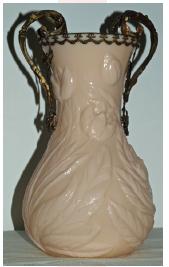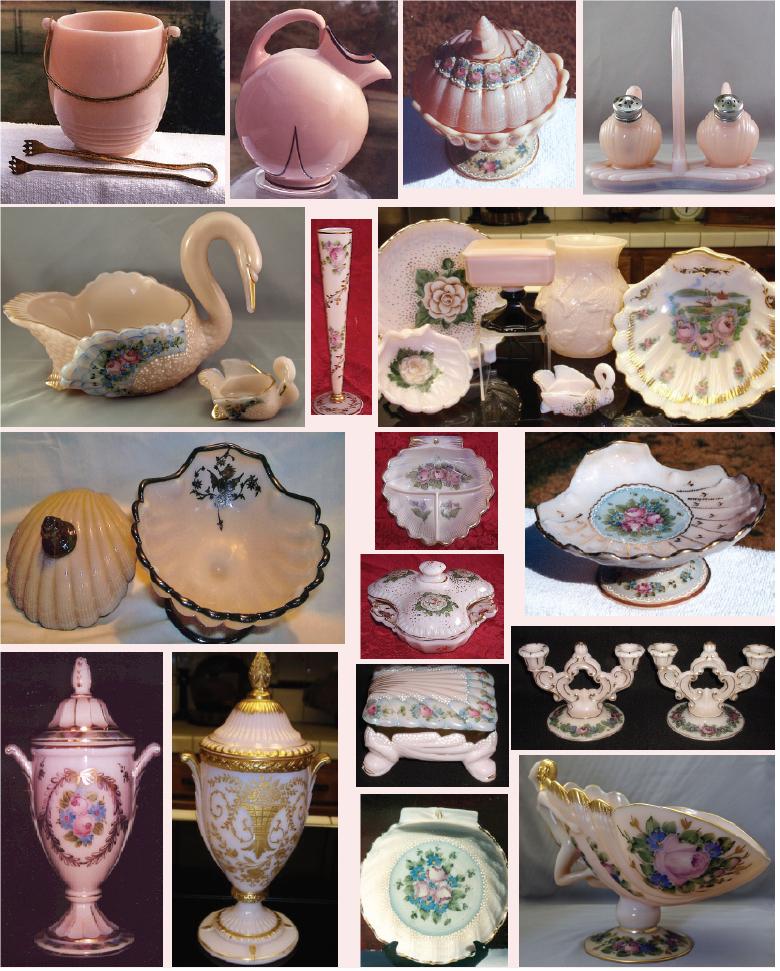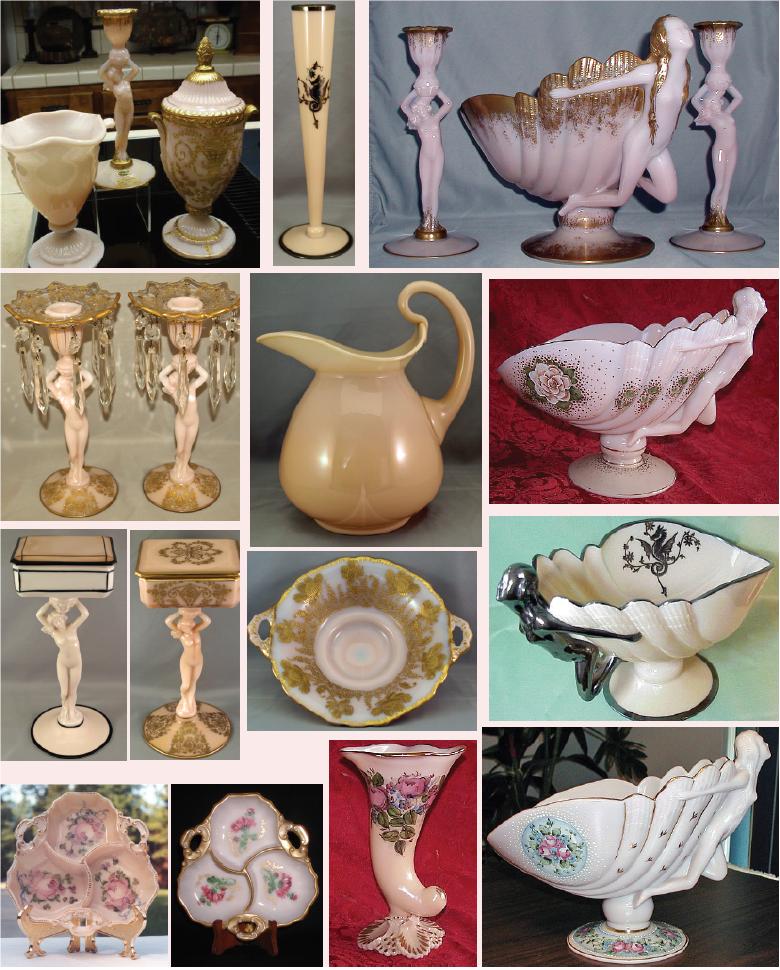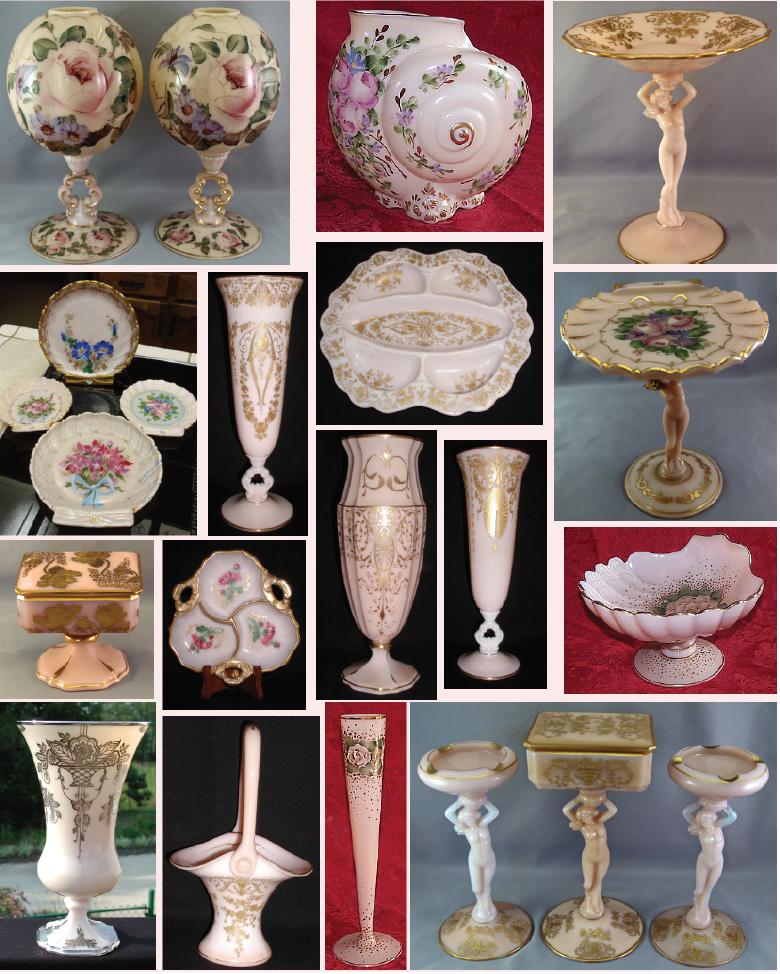Crown Tuscan
by Mark Nye
Issue No. 430 - August 2009
Henry Hellmers, a graduate of the University of Michigan, arrived at the Cambridge Glass Co. in 1930 and worked there until 1932 when he joined the staff at Akro Agate. One of the fruits of his labors at Cambridge was Crown Tuscan, introduced during the summer of 1932.
"The Chicago showrooms of Cambridge Glass Co. are displaying the 'Crown Tuscan' line which has been received with much interest since its recent announcement. This opaque glass with its rich cream-like color is offered in a wide choice of fancy and table pieces including vases, bowls, side dishes, ball jugs, etc. This Cambridge line carries a hall-mark on the bottom of each after the manner of dinnerware. This hall-mark consists of a crown with the name 'Tuscan'."
The preceding came from the September 1932 issue of China, Glass and Lamps and was probably the first report of the new Cambridge color to appear in the trade journals.
Crown Tuscan is a "pinkish" color, sometimes described as being near "flesh color," that ranges from opaque to near translucent in density, the former being the most prevalent. It is found in a wide range of shades, from dark tan through shades of pink to almost white. One writer, soon after the color's debut, described it as a "whitish pink opaque glass." There were two formulas used for making Crown Tuscan, one for blown ware and the other for pressed ware. Ideally two such formulas are put together to produce the same color but often there is a slight variation in the color between the two types of glass. That the color was hard to control and keep constant is demonstrated by a recently discovered Cambridge "Circular Letter" dated March 28th, 1934 and sent to all agents.
"We are afraid that you have some Crown Tuscan samples in your sample room or in your road samples that are not just exactly right, as we find that during December and the first part of the year the Crown Tuscan we made was entirely too light and did not have the pinkish cast that we had in the Crown Tuscan made all of last year. Too much of the Crown Tuscan that has been made this year is very white and washy. We wish you would go through your samples and pick out the incorrect colored ones and return them to us, sending us a list of samples for replacement. Please do this immediately, as the Crown Tuscan is one of our leading lines, and we wish to have the samples displayed correctly."
This certainly explains the presence of the "white" Crown Tuscan seen by collectors today. The question is why this variation was not questioned earlier and how much was actually shipped to wholesale customers and then sold to retail customers.
The quote from CGL in the opening paragraph describes quite well the range of items produced in Crown Tuscan during the early years. Two pages of the 1933 Cambridge catalog supplement were devoted to Crown Tuscan and one of these illustrates nothing but vases, 12 to be exact. These were decorated with gold D/1007 or a gold encrusted etching Diane, Portia or Chintz No. 2. Other items in Crown Tuscan shown on the 1933 catalog pages included the #1040 3½ inch swan, the 1043 8½ inch swan and four items from the Statuesque or 'Nude" line, the candlestick, ashtray, cigarette box and comport, all decorated with D/1007-8.
The 1934 catalog supplement contained four pages of ware available in Crown Tuscan with a number of the pieces shown with gold encrusted etchings, including Portia, Diane, Minerva and Valencia. These same pieces were, of course, also available plain. Among the blanks illustrated, not decorated, was the 3400/152 76 oz. Doulton style jug. The fourth page was entirely devoted to showing footed items with the foot in Ebony. This grouping included three pieces from the Statuesque (3011) Line, the Ash Tray, 7 in. comport and the cigarette box with cover.
In addition to lines previously mentioned, the 1930s
 saw blanks from the Nautilus and Everglades (at left) line made
in Crown Tuscan, as well as the Mannequin Head. It is
from this period that we have the Statuesque or Nude
cocktails with stem and foot in Crown Tuscan and
bowls in colors of Amber, Amethyst, Carmen, Forest
Green, Gold Krystol and Royal Blue. These had been
discontinued by the end of the 1930s.
saw blanks from the Nautilus and Everglades (at left) line made
in Crown Tuscan, as well as the Mannequin Head. It is
from this period that we have the Statuesque or Nude
cocktails with stem and foot in Crown Tuscan and
bowls in colors of Amber, Amethyst, Carmen, Forest
Green, Gold Krystol and Royal Blue. These had been
discontinued by the end of the 1930s.
The Crown Tuscan trademark (shown at right) was used only during
the early years of the line's production, perhaps only
 for the first two or three years, and not every piece was
signed as stated in the trade journal report. The mark
was used on blanks decorated with gold encrusted
etchings; gold decorates such as D/1007, and enamel.
It was not placed on non-decorated blanks. At least
one non-decorated piece has been seen with the mark
and this was on a piece known to have been intended
for decoration.
for the first two or three years, and not every piece was
signed as stated in the trade journal report. The mark
was used on blanks decorated with gold encrusted
etchings; gold decorates such as D/1007, and enamel.
It was not placed on non-decorated blanks. At least
one non-decorated piece has been seen with the mark
and this was on a piece known to have been intended
for decoration.
With the 1935 introduction of the Sea Shell line came a new color name, Coral. Because of Cambridge advertising and trade descriptions of the new line and color, there has been much debate whether or not Coral was a distinct color, separate from Crown Tuscan. No substantial evidence has been found that there was a separate formula for Coral. The name Coral was used only in conjunction with the Sea Shell line; no other lines were ever listed as being available in Coral.
In the introduction to the January 1, 1940 Cambridge price list, Crown Tuscan and Coral are both described as "Opaque Shell Pink." However, once again Coral was used only in conjunction with the Sea Shell line. By 1945 the name Coral had disappeared from Cambridge price lists and what remained of the Sea Shell line was available in Crystal and Crown Tuscan. Currently, the generally accepted theory is that Coral was a color name created by the Cambridge Sales Department, not a formulated color, and is Crown Tuscan with a different name.
In addition to gold encrusted etchings, enamel decorations were also used on Crown Tuscan pieces and these date to before 1940 and probably to the first years of the color's production.
From the 1940 Cambridge price list it can be learned that the Crown Tuscan line for 1940 consisted of 23 items not decorated and 22 pieces available with any of four gold encrusted etchings: Portia, Diane, Rose Point and Candlelight. The non-decorated ware included the No. 647 candleholder and two items from the Nude line, the 9 inch candlestick and candelabrum. Fifteen of the Crown Tuscan items offered in the 1940 catalog were vases. The only difference between the listings for decorated and non-decorated items was the absence of the No. 1040 3 inch swan from the decorated listing.
The effects of World War II were felt at the Cambridge factory and the entire line decreased dramatically as raw materials and labor just were not available. Post war, the Crown Tuscan line had been reduced to eighteen pieces not decorated and sixteen decorated with gold encrusted Diane, Portia, Rose Point and Candlelight. One piece, the Pristine 384 11 in. oval bowl was offered plain or with D/450 and not with any of the etchings.
As the company, and the nation as a whole, recovered from the war, Cambridge prepared and issued, in 1949, a new catalog, the first since January 1940. The price list that accompanied the catalog offered 9 items from the Sea Shell line and 16 from other lines in Crown Tuscan. Still being made were the "Flying Lady" bowl and the 9 inch nude candlestick. There were three vases that were not offered in 1940, the nos. 1236, 1237 and 1238.
For reasons we will never know, a supplemental catalog page probably issued during 1951 used the color name Coral in connection with four pieces, the MV 102 Miniature Urn, the Pristine 578 Miniature Cornucopia, the 702 Miniature Cornucopia and the 1040 3 inch swan. Corresponding price lists did not use the Coral name, all the pieces continued to be listed as Crown Tuscan This use does not change the belief that Coral was not a formulated color, but rather simply a marketing name.
The last mention of Crown Tuscan is in the March 1952 price list with both plain and decorated items offered. Twelve pieces were available etched with one of four gold encrusted etchings, Portia, Diane, Rose Point and Candlelight. Among these was the 3011 9 inch candlestick. An additional twenty-two pieces were available with D/1018, gold stippled edge. This latter group also included the 3011 candlestick as well as the two sizes of swans, 3 inch and 8½ inch.
A new price list was issued October 5, 1953 and, as it turned out, was the final general price for the original Cambridge Glass Co. Color production had been scaled back and Crown Tuscan was no longer offered. Thus, after twenty-one years, Crown Tuscan ceased to be a part of the Cambridge line.
Not only was Crown Tuscan an important product line for Cambridge, it was also the same for at least one other company, a decorating company that purchased large quantities of Crown Tuscan blanks and then decorated them. The company was Abels, Wasserberg & Company located at 23rd East 26th Street, New York City and with a decorating studio at 63 Greene Street. During the early years of the company, they relied heavily, if not exclusively, on imports, but then World War II brought an end to European and Asian imports and they turned to domestic producers for their blanks. Crown Tuscan pieces were purchased from Cambridge and then decorated with enamels, primarily with floral designs, roses being a popular subject. This line of decorated blanks was called the "Charleton Line" by Abels, Wasserberg & Co. and it proved to be popular then and the pieces today are sought after, not only by Cambridge collectors but by others as well.
Another decorating company that also purchased Crown Tuscan blanks was Rockwell Silver Company and their sterling silver decorated Crown Tuscan blanks are highly prized by collectors. Among the better known designs is the Sea Horse.
Some years after leaving Cambridge, Henry Hellmers, then working for the Alladin Lamp Company, developed another pink opaque color that Alladin named Alacite. It is similar to, but different from, Crown Tuscan; the formulas were different and Crown Tuscan was a pot glass while Alacite was a tank glass. (One distinctive feature of the two types is the volume of glass in a pot was sufficient only for a single day's operation while tank glass was made in a much larger volume and used continuously for a period of many days.) According to Mr. Hellmers, as related to Bill Courter, the reports that Cambridge made lamps for Alladin are untrue.
As far as it is known, neither Imperial Glass Co. nor Summit Art Glass ever produced glass in Cambridge molds using a color similar to Crown Tuscan.



